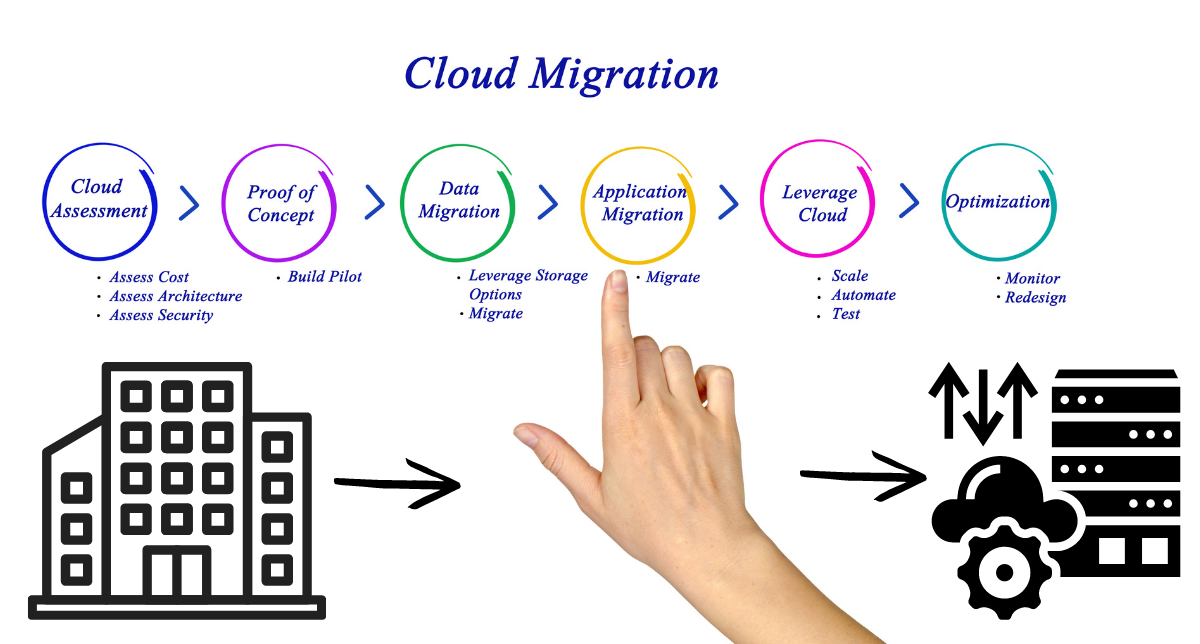Cloud migration, a pivotal concept in the realm of information technology, refers to the process of transitioning an organization's data, applications, and workloads from on-premises infrastructure to cloud-based services. This strategic move is driven by the desire to harness the scalability, flexibility, and cost-efficiency offered by cloud computing platforms. From an academic standpoint, understanding the nuances of cloud migration involves delving into its methodologies, challenges, and the profound impact it has on organizational processes and dynamics.
 |
| Navigating Cloud Migration: An Academic Exploration |
Methodologies of Cloud Migration:
1. Rehosting (Lift and Shift):
Rehosting is the simplest and most straightforward cloud migration approach. In this method, existing applications and data are lifted from on-premises infrastructure and shifted to the cloud without significant modification. While this method is quick and requires minimal changes, it may not fully capitalize on the benefits of cloud-native features.
2. Replatforming (Lift, Tinker, and Shift):
Re-platforming involves making slight adjustments to applications before migrating them to the cloud. This could include optimizing the application architecture to better align with cloud services, resulting in improved performance and cost-efficiency. It strikes a balance between speed and optimization compared to rehosting.
3. Refactoring (Re-architecting):
Refactoring, also known as re-architecting, entails redesigning and redeveloping applications to take full advantage of cloud-native features. This method often leads to better scalability, resilience, and efficiency. While it requires more effort and time, the long-term benefits in terms of performance and cost-effectiveness can be substantial.
4. Re-architecting (Rebuilding):
Rearchitecting involves rebuilding applications from scratch, adopting a cloud-native approach to fully leverage the capabilities of the cloud environment. This method offers the highest level of optimization but requires significant resources and expertise.
Challenges in Cloud Migration:
1. Security Concerns:
Security is a paramount concern in cloud migration. Organizations must ensure that sensitive data remains secure during and after the migration process. Implementing robust encryption, access controls, and compliance with industry regulations are critical aspects of addressing security challenges.
2. Data Migration:
The seamless transfer of data from on-premises systems to the cloud is a complex task. Ensuring data integrity, minimizing downtime, and managing potential data conflicts require meticulous planning and execution.
3. Integration with Existing Systems:
Organizations often have a mix of legacy and modern systems. Integrating cloud-based services with existing on-premises systems can be challenging. Compatibility issues, data synchronization, and maintaining system functionality during the migration process are critical considerations.
4. Cost Management:
While cloud migration offers potential cost savings, effectively managing and optimizing costs is a continuous challenge. Organizations need to understand the pricing models of cloud service providers, monitor resource usage, and implement cost-control measures.
Impact on Organizational Processes:
1. Agility and Scalability:
Cloud migration empowers organizations with increased agility and scalability. The ability to scale resources up or down based on demand ensures that organizations can adapt to changing requirements and seize new opportunities in a dynamic market.
2. Collaboration and Accessibility:
Cloud-based services facilitate collaboration by providing a centralized and accessible platform for employees, irrespective of their physical location. Real-time collaboration tools enhance communication and teamwork, fostering a more connected and efficient work environment.
3. Innovation and Time-to-Market:
Cloud-native features enable organizations to innovate rapidly and bring new products and services to market more quickly. The availability of managed services and development platforms reduces the time and effort required for application development and deployment.
4. Resilience and Disaster Recovery:
Cloud environments offer built-in redundancy and disaster recovery capabilities, enhancing the resilience of organizational systems. Automated backups, data replication, and failover mechanisms contribute to minimizing downtime and data loss.
From an academic perspective, the exploration of cloud migration encompasses a multifaceted understanding of methodologies, challenges, and organizational impacts. As technology continues to evolve, the strategic decision to migrate to the cloud becomes increasingly relevant for organizations seeking to optimize their IT infrastructure. The academic study of cloud migration serves not only to unravel the intricacies of this transformative process but also to equip future professionals with the knowledge and skills necessary to navigate the dynamic landscape of cloud computing.



